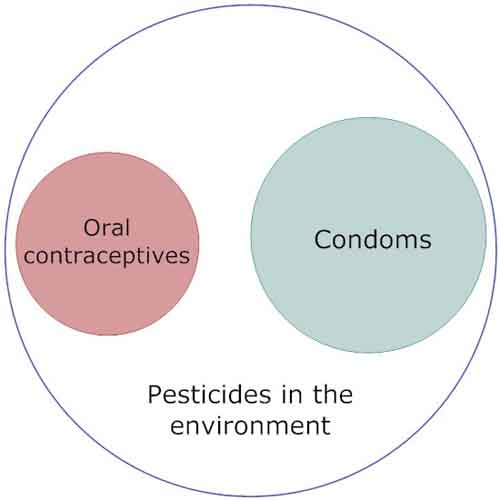Back in March 2008, I wrote about the issue of pharmaceutical drugs in your drinking water. It wasn’t really a surprise to anyone who was actually keeping abreast of the issue as these drugs had first been detected as early as the 1970’s. But 2008 was the first time a major news source had decided to report on the story — thus bringing it the forefront of debate. Government regulators and mainstream scientists, however, were able to push the story off the radar by claiming, “Yes, there are pharmaceutical drugs in the water, but at levels so low that they present no threat to the public at large.” And unfortunately, although we had strong reason to believe the government argument wasn’t true, we had little data to support the contention. Well, now it’s been four years since that story first broke — and disappeared — and it’s time to take another look, because now we have new data to look at.
History of pharmaceutical drugs in drinking water
As we’ve discussed previously, there are somewhere around 3,000 pharmaceutical drugs in common use. These include:
- Cold medications
- Cholesterol drugs
- Antidepressants
- Birth control pills
- Heart medications
- Antibiotics
- And highly, highly toxic chemotherapy drugs
Residues of these drugs pass out into the sewage system from your urine, fecal matter, and even from your sink after you rinse out your dispensing cup. And of course, this list doesn’t include non-pharmaceuticals such as all of the lotions and potions and cosmetics that wash off when you bathe or shower — or an entire world of over-the-counter drugs or whatever. Quite simply it is impossible for sewage facilities to remove all trace of the drugs from the water they treat. In some districts the treated water, still containing traces of the pharmaceuticals, goes back immediately into the public water supply and into your home. In other communities it is dumped into rivers as “clean” water for the drugs to be picked up downstream by the next community’s municipal water supply. Or in some cases, the drug laden water makes its way down into aquifers to be pumped up later as somebody’s well water.
Then again, that’s the best case scenario. In many communities, sewage pipes leak or septic tanks overflow, which releases untreated water directly into the environment, with these drugs at their highest concentration so they can make their way into local water tables. Then of course, the residue of many of these drugs, in the form of used bottles and vials, make their way “full strength” into landfills — only to then leach down into underground water resources or “run off” into lakes and rivers. And in some parts of the world, the U.S. included, untreated water is sometimes dumped directly into rivers and streams. Inevitably, then, these drugs make their way back to us in our drinking water.
 As I mentioned earlier, it was in the 1970’s that pharmaceutical drug residues were first detected in our waterways. But the common thinking of bureaucratic legislators was that the amounts were so low that they couldn’t possibly have any impact on overall health; and besides, in an age when dead fish were a common sight floating in rivers, when other rivers burned,1 Chapel Hill Fiddler. “The Cuyahoga River Fire of 1969.” 16 March 2005. Pratie Place. (Accessed 22 Jan 2012.) <http://pratie.blogspot.com/2005/03/cuyahoga-river-fire-of-1969.html> and people wrote popular songs about “dirty water,”2 The Standells. <http://www.youtube.com/watch?v=kqKHqWaTv9g> why would anyone worry about pharmaceutical drugs present in amounts measured in the billionths of a gram per quart/liter of water?
As I mentioned earlier, it was in the 1970’s that pharmaceutical drug residues were first detected in our waterways. But the common thinking of bureaucratic legislators was that the amounts were so low that they couldn’t possibly have any impact on overall health; and besides, in an age when dead fish were a common sight floating in rivers, when other rivers burned,1 Chapel Hill Fiddler. “The Cuyahoga River Fire of 1969.” 16 March 2005. Pratie Place. (Accessed 22 Jan 2012.) <http://pratie.blogspot.com/2005/03/cuyahoga-river-fire-of-1969.html> and people wrote popular songs about “dirty water,”2 The Standells. <http://www.youtube.com/watch?v=kqKHqWaTv9g> why would anyone worry about pharmaceutical drugs present in amounts measured in the billionths of a gram per quart/liter of water?
Unfortunately, despite government denials of any danger, there were canaries in the coal mine — animal warnings that indicated something might be very wrong. For example, there was the U.S. Geological Survey in 2006 that found that large numbers of small mouth bass in the Potomac River were found to be abnormally inter-sexed. That is, the same fish displayed both male and female sexual characteristics.3 “Summary of U.S. Geological Survey (USGS) Information Related to the Intersex Characteristics of Fish in the Potomac Watershed.” USGS. 4 Oct 2006. <http://chesapeake.usgs.gov/feature/fishhealthWWWfeature.pdf> Not nice. Or the 2007 study out of Canada that found that male fish were being feminized by the traces of birth control pills that made their way into lakes and streams.4 John Roach. “Sex-Changing Chemicals Can Wipe Out Fish, Study Shows.” National Geographic News. May 21, 2007. (Accessed 22 Jan 2007.) <http://news.nationalgeographic.com/news/2007/05/070521-sex-fish.html> And then, of course, for those who think that animal studies don’t necessarily relate to humans, there was the apparent doubling in the frequency of undescended testis in England and Wales in 1962-81.5 Clair Chilvers , D. Forman , M.C. Pike , K. Fogelman , M.E.J. Wadsworth. “Apparent Doubling of Frequency of Undescended Testis in England and Wales in 1962-81.” I, Volume 324, Issue 8398, Pages 330 – 332, 11 August 1984 Or the studies that have found that the age of puberty in young girls keeps dropping year by year.6 Frank M. Biro, Maida P. Galvez, Louise C. Greenspan, Paul A. Succop, et al. “Pubertal Assessment Method and Baseline Characteristics in a Mixed Longitudinal Study of Girls.” Pediatrics Vol. 126 No. 3 September 1, 2010 pp. e583 -e590. <http://pediatrics.aappublications.org/content/126/3/e583.full> At one time, it averaged 15-16. It’s now running at 7-8 — and with more and more girls showing signs of puberty as early as age three!!7 Grete Teilmann, Carsten B. Pedersen, Tina Kold Jensen, et al. “Prevalence and Incidence of Precocious Pubertal Development in Denmark: An Epidemiologic Study Based on National Registries.” PEDIATRICS Vol. 116 No. 6 December 1, 2005 pp. 1323 -1328. <http://www.pediatricsdigest.mobi/content/116/6/1323.full>
Look, there are many toxins in water including pesticides, heavy metals, and industrial waste; but pharmaceutical drugs are particularly worrisome because of their affinity for human beings. In point of fact, they are designed with that in mind — to specifically react with human tissue. That’s why even trace amounts of pharmaceuticals in drinking water supplies are such a threat.
Don’t look to governments for help in the near term
Although governments are aware of the problem (Europe first identified clofibric acid, a cholesterol-lowering drug, in groundwater in the early 1990’s), no effective regulations exist for removing the threat. And even those regulations that exist, as weak as they are, are rarely enforced. To make matters worse, the current economic environment makes any strong enforcement unlikely for the foreseeable future. Ozonation, reverse osmosis, distillation, and charcoal filters can all remove at least 80% of pharmaceutical contaminants if used at the local level in your house, but are only about 50% effective with the large volumes of water seen at municipal water plants,8 Mompelat S, Thomas O, Le Bot B. “Contamination levels of human pharmaceutical compounds in French surface and drinking water.” J Environ Monit. 2011 Oct 4;13(10):2929-39. Epub 2011 Sep 12. <http://www.ncbi.nlm.nih.gov/pubmed/21912785> and they are expensive. And even if it were feasible, it is now politically impossible. The EPA, which is responsible for policing environmental rules, has been singled out for Republican criticism during the primaries. Of the candidates still standing, Mitt Romney has said the EPA is “out of control.” Newt Gingrich has called for it to be overhauled and made more business friendly. Rick Santorum has derided the EPA’s efforts to control mercury pollution from coal plants — the source of most mercury in your drinking water, and ultimately in your seafood. And Ron Paul has called for the EPA’s outright elimination. As for President Obama and the environment, his record is decidedly mixed — pushing for higher fuel standards on cars, but continually caving to pressure from the business community when it comes to air and water pollution.
 Keep in mind that worldwide some $800 billion in drugs are sold each year. That’s a heck of a lot of residual drug waste running down our drains and toilets and into our environment. But even worse, that’s a heck of a lot of financial profit for the pharmaceutical companies that can be used to influence world leaders to not “overact” when it comes to regulating their interests. And it’s not just the pharmaceutical companies. All industry fights expensive pollution controls. Elected officials simply cannot overcome these forces. But it’s not just elected officials; after all, we see the same, or higher, levels of environmental pollution in China.
Keep in mind that worldwide some $800 billion in drugs are sold each year. That’s a heck of a lot of residual drug waste running down our drains and toilets and into our environment. But even worse, that’s a heck of a lot of financial profit for the pharmaceutical companies that can be used to influence world leaders to not “overact” when it comes to regulating their interests. And it’s not just the pharmaceutical companies. All industry fights expensive pollution controls. Elected officials simply cannot overcome these forces. But it’s not just elected officials; after all, we see the same, or higher, levels of environmental pollution in China.
Some day public outrage will be strong enough to assert itself over political inertia, but that day is not today. Which brings us to the latest study, which at least moves us closer to that day.
Prostate Cancer
Research published in BMJ Open last November strongly suggests that there may be a link between synthetic estrogen from oral contraceptives (OC) that has found its way into the environment and the rising rate of prostate cancer among men around the world.9 David Margel, Neil E Fleshner. “Oral contraceptive use is associated with prostate cancer: an ecological study.” BMJ Open 2011;1:e000311. <http://bmjopen.bmj.com/content/1/2/e000311.full> It should be noted that the study did not “prove” a cause and effect relationship. It merely demonstrated an extremely strong statistical relationship.
The researchers analyzed multiple forms of contraception including intrauterine devices, condoms, vaginal barriers, and the pill as they were used in 87 different countries. They then compared the usage of those contraceptives against the incidence and mortality rates from prostate cancer. As the lead author, David Margel, a urologist and fellow in uro-oncology said, “Looking at these percentages, we find a strong correlation between female use of oral contraceptives at a population level and both new cases of prostate cancer and mortality from prostate cancer. This was not found among other contraceptive modes.”
As a further clarification, he stated, “What we found was that in countries where the oral contraceptive was used more often, prostate cancer had a greater incidence.” While the amount of estrogen excreted by any single individual is extremely small, “when millions of women are doing it and for a long period of time, it may cause low environmental estrogen levels,” Dr. Margel explained.
Now, keeping in mind that this is a preliminary study, the results are still disturbing. Yes, as noted above, the results do not “prove” causality — that oral contraceptives in the water supply actually “cause” prostate cancer — but they do raise a very bright red flag. And they are far more damning than some of the comments on the study website (reference 8, as cited above) would have us believe. Those comments disputed the study’s results, instead attempting to assign blame to things such as pesticides in the water or the “fact” that women on the pill had more sexual relations than other women. But in fact, the study results marginalize both those possibilities.
If economics can be called the “dismal science” for its sometimes negative predictions, then statistical analysis might be called the “dark science” for its arcane methodology that can often be understood only by its initiates. But even a cursory examination of this study’s methodology from a lay perspective provides enough information to comprehend why this study’s results are so disturbing and why the counter arguments don’t hold up.
Study methodology and results
The primary source of the study’s data was the United Nations World Contraceptive Use 2007 report,10 “United Nations World Contraceptive Use, 2007.” <http://www.un.org/esa/population/publications/contraceptive2007/WallChart_WCU2007_Data> from which the researchers extracted the percentage of women of reproductive age from 87 different countries using OCs, intrauterine devices, condoms, or vaginal barriers. The rationale for examining alternate uses of birth control was to examine specificity for OCs, as it is plausible that this measure is a marker of sexual activity (the specific issue raised in one of the comments), which itself has demonstrated some inconsistent association with prostate cancer.11 Schlaberg R, Choe DJ, Brown KR, et al. “XMRV is present in malignant prostatic epithelium and is associated with prostate cancer, especially high-grade tumors.” Proc Natl Acad Sci U S A 2009;106:16351–6. <http://www.pnas.org/content/106/38/16351.full> In addition to global incidence and mortality, the researchers also examined continent specific and Europe specific outcomes so as to test the association among a more homogenous group with narrower ranges of both OC use and prostate cancer incidence/mortality. They also made use of the CIA World Factbook to retrieve information on gross domestic product per capita in each country to control for prostate cancer screening tendencies, since countries with a higher GDP are more prone to screen for prostate cancer.
In the end, the researchers found that OC use was significantly correlated with prostate cancer incidence and mortality in the individual nations worldwide…and by continent. All other forms of contraceptives (i.e., intrauterine devices, condoms or vaginal barriers) were not correlated with prostate cancer incidence.
As I stated earlier, this methodology pretty much rules out increased sexual activity as the culprit. And the following Venn diagram clearly illustrates why pesticides are not likely responsible.

As you can see, in any given country, OC use and condom use exist within the world of pesticides in the environment. It doesn’t matter whether women use oral contraceptives or condoms, men are exposed to the same levels of pesticides. Thus, if pesticides were the cause of the increased rates of prostate cancer, then the levels of OC use and condom use would have no impact on the results. As it turns out, that is true for condoms, but not for oral contraceptives. The higher the use of oral contraceptives by women in a particular environment, the higher is the incidence and mortality of prostate cancer for men living in the same environment. In other words, OCs are the variable in the equation, not pesticides — and not sexual activity. Note: I made the circle for condoms bigger than the circle for oral contraceptives since condom use is the preferred contraception of choice throughout most of the world. And if increased sexual activity was responsible, we would expect to see increases in prostate cancer with the increased use of any form of contraception, but that doesn’t appear to be happening. The only statistical correlation could be found with OC use.
Again, the study doesn’t prove causality, only a statistical connection. As the researchers said, “We think further research is needed to explore both oral contraceptives, but also other estrogenic compounds that may contaminate our environment and may cause and increase the incidence and mortality from prostate cancer.”
The bottom line is that the study certainly raises concerns and warrants further investigation.
Deliberately adding pharmaceutical drugs to water
 And now there’s a potentially new wrinkle in the fabric of health when it comes to pharmaceutical drugs in our drinking water. Some doctors have been suggesting that it might be a good idea to add statin drugs to the public water supply to improve general health. For example, one of Northern Ireland’s top heart experts, Professor Mahendra Varma, called for them to be put in Northern Ireland’s water supply.12 JOHN NAISH. “Why taking statins might be pointless – and even bad for you.” 22 December 2010. Mail Online. (Accessed 25 Jan 2012.) <http://www.dailymail.co.uk/health/article-1340299/Why-taking-statins-pointless–bad-you.html> As a consulting cardiologist, he has long believed “everyone” should be taking a statin as a preventative measure to keep cholesterol levels down — something he says would lower the devastating rates of heart disease and stroke, two of Northern Ireland’s biggest killers.
And now there’s a potentially new wrinkle in the fabric of health when it comes to pharmaceutical drugs in our drinking water. Some doctors have been suggesting that it might be a good idea to add statin drugs to the public water supply to improve general health. For example, one of Northern Ireland’s top heart experts, Professor Mahendra Varma, called for them to be put in Northern Ireland’s water supply.12 JOHN NAISH. “Why taking statins might be pointless – and even bad for you.” 22 December 2010. Mail Online. (Accessed 25 Jan 2012.) <http://www.dailymail.co.uk/health/article-1340299/Why-taking-statins-pointless–bad-you.html> As a consulting cardiologist, he has long believed “everyone” should be taking a statin as a preventative measure to keep cholesterol levels down — something he says would lower the devastating rates of heart disease and stroke, two of Northern Ireland’s biggest killers.
Now, I realize that the call to add statin drugs to the water supply is made half in jest — to make a point. But keep in mind; if something is “half” in jest, then the other half is not. There’s an element of seriousness to it. And remember, Dr. Varma didn’t just say it once. He has repeatedly stated that he believes “everyone” should be taking a statin drug as a preventative measure despite the fact that studies have shown that doing so does not add one single day to your life. And in an example of life imitating insanity, in 2010, the FDA authorized AstraZeneca to sell its product Crestor to a potential new market of 6.5 million people, none of whom actually have cholesterol or heart problems. (You read that correctly — no problems, no symptoms!) That’s because the company got the FDA to agree that Crestor, a statin drug, could be sold as a preventative measure. The trigger for the approval was the “highly touted” international Jupiter Cohort Study, which happened to be paid for by AstraZeneca.
That said, there is a great deal of false information and fear mongering circulating in the alternative health community about this issue. For example, often cited as recommending putting statins in the water supply is a November 2008 panel discussion sponsored by the American Heart Association and featuring Robert Bonow, M.D., of Northwestern University in Chicago, Gordon F. Tomaselli, M.D., of Johns Hopkins University in Baltimore, and Anthony De Maria, M.D., of the University of California at San Diego. But in fact, if you listen to the actual discussion, no such recommendation is made.13 <http://www.youtube.com/watch?v=yGgCm46Tn0g>
Also frequently cited is the Op-Ed response by George Lundberg, MD, the editor of MedPage Today, to the question, “Should We Put Statins in the Water Supply?” But again, if you actually listen to his response, or read the transcript, you will see that Dr. Lundberg completely avoids answering the question and instead, addresses himself to the value of the six drug “polypill” for use in controlling cholesterol.14 George Lundberg. “Should We Put Statins in the Water Supply?” 10 Jan 2011. Medpage Today. (Accessed 25 Jan 2012.) <http://www.medpagetoday.com/Columns/At-Large/24259> And when other publications, such as Therapeutics Initiative have asked the same question, they too have avoided directly answering the question but have indirectly shot the idea down — in fact, questioning the very value of some of the statin supportive studies.15 “Do statins have a role in primary prevention? An update.” Therapeutics Letter Issue 77 / Mar – Apr 2010. <http://www.ti.ubc.ca/letter77>
So all in all, the fact that doctors have raised the question of whether or not statins should be added to the water supply means very little. Any action on the issue is far from imminent and far less frightening, than some of the fear mongers would have you believe. In fact, once you take a closer look, you find that almost all of these articles are actually the same original misinformation published and republished over and over.16 Paul Joseph Watson. “Health Authorities Want Depression-Causing Drugs Added To Water Supply.” 10 Jan 2011. Alex Jones’ Infowars. <http://www.infowars.com/health-authorities-want-depression-causing-drugs-added-to-water-supply/> ,17 Annie. “Health Authorities Want Depression-Causing Drugs Added To Water Supply.” February 15, 2011. Health Freedom Alliance. (Accessed 25 Jan 2012.) <http://healthfreedoms.org/2011/02/15/health-authorities-want-depression-causing-drugs-added-to-water-supply-2/> Nevertheless, based on past history, how much of a stretch is it to believe that government regulators might “someday” seriously consider authorizing the addition of statin drugs to the water supply — especially when you consider that they’ve already given approval to add another highly toxic substance to the water supply for dubious health benefits? And yes, I’m talking about fluoride for the prevention of dental caries. As with statin drugs, the claims for any health benefits for fluoride turn out to be rather dubious at best, while at the same time, its harmful side effects are well documented. All it takes is a politician in power who believes he can score points with the electorate, along with a small financial incentive from a pharmaceutical lobbyist, to decide the time is right to mandate adding statin drugs to the water supply. Sometimes, as in Texas with Rick Perry mandating Gardasil, the public uproar overturns the decision.18 Steven Ertelt. “Rick Perry Admits Mistake on Gardasil-HPV Vaccine Decision.” 15 Aug 2011. LifeNews.com (Accessed 25 Jan 2012.) <http://www.lifenews.com/2011/08/15/rick-perry-admits-mistake-on-gardasil-hpv-vaccine-decision/> But other times, as with fluoridation, it does not.
Conclusion
The presence of pharmaceutical drugs in the water is a very real issue. We don’t have to deal in hypothetical fear mongering, at least for the present, about concerns that governments may be deliberately adding statin drugs or antidepressants to our water. There is a clear and present danger that we already face with all of these drugs, and a whole host of others, already present in our water supply as a result of them accidentally making their way into our drinking water. And we don’t have to wait for clear, irrefutable evidence that these drugs may be harmful even in trace amounts. Such evidence is likely to be 10 to 20 years down the road. We already have enough red flags, canaries in the coal mine, to take all necessary precautions immediately. How many intersex fish do you need to see? How many studies statistically connecting prostate cancer to oral contraceptives in the water are required for you to act — especially when action is so simple?
- Clean up your water at the tap and in the bath
- Detox regularly
- And consider using a low-dose, all-natural men’s or women’s progesterone crème.

References
| ↑1 | Chapel Hill Fiddler. “The Cuyahoga River Fire of 1969.” 16 March 2005. Pratie Place. (Accessed 22 Jan 2012.) <http://pratie.blogspot.com/2005/03/cuyahoga-river-fire-of-1969.html> |
|---|---|
| ↑2 | The Standells. <http://www.youtube.com/watch?v=kqKHqWaTv9g> |
| ↑3 | “Summary of U.S. Geological Survey (USGS) Information Related to the Intersex Characteristics of Fish in the Potomac Watershed.” USGS. 4 Oct 2006. <http://chesapeake.usgs.gov/feature/fishhealthWWWfeature.pdf> |
| ↑4 | John Roach. “Sex-Changing Chemicals Can Wipe Out Fish, Study Shows.” National Geographic News. May 21, 2007. (Accessed 22 Jan 2007.) <http://news.nationalgeographic.com/news/2007/05/070521-sex-fish.html> |
| ↑5 | Clair Chilvers , D. Forman , M.C. Pike , K. Fogelman , M.E.J. Wadsworth. “Apparent Doubling of Frequency of Undescended Testis in England and Wales in 1962-81.” I, Volume 324, Issue 8398, Pages 330 – 332, 11 August 1984 |
| ↑6 | Frank M. Biro, Maida P. Galvez, Louise C. Greenspan, Paul A. Succop, et al. “Pubertal Assessment Method and Baseline Characteristics in a Mixed Longitudinal Study of Girls.” Pediatrics Vol. 126 No. 3 September 1, 2010 pp. e583 -e590. <http://pediatrics.aappublications.org/content/126/3/e583.full> |
| ↑7 | Grete Teilmann, Carsten B. Pedersen, Tina Kold Jensen, et al. “Prevalence and Incidence of Precocious Pubertal Development in Denmark: An Epidemiologic Study Based on National Registries.” PEDIATRICS Vol. 116 No. 6 December 1, 2005 pp. 1323 -1328. <http://www.pediatricsdigest.mobi/content/116/6/1323.full> |
| ↑8 | Mompelat S, Thomas O, Le Bot B. “Contamination levels of human pharmaceutical compounds in French surface and drinking water.” J Environ Monit. 2011 Oct 4;13(10):2929-39. Epub 2011 Sep 12. <http://www.ncbi.nlm.nih.gov/pubmed/21912785> |
| ↑9 | David Margel, Neil E Fleshner. “Oral contraceptive use is associated with prostate cancer: an ecological study.” BMJ Open 2011;1:e000311. <http://bmjopen.bmj.com/content/1/2/e000311.full> |
| ↑10 | “United Nations World Contraceptive Use, 2007.” <http://www.un.org/esa/population/publications/contraceptive2007/WallChart_WCU2007_Data> |
| ↑11 | Schlaberg R, Choe DJ, Brown KR, et al. “XMRV is present in malignant prostatic epithelium and is associated with prostate cancer, especially high-grade tumors.” Proc Natl Acad Sci U S A 2009;106:16351–6. <http://www.pnas.org/content/106/38/16351.full> |
| ↑12 | JOHN NAISH. “Why taking statins might be pointless – and even bad for you.” 22 December 2010. Mail Online. (Accessed 25 Jan 2012.) <http://www.dailymail.co.uk/health/article-1340299/Why-taking-statins-pointless–bad-you.html> |
| ↑13 | <http://www.youtube.com/watch?v=yGgCm46Tn0g> |
| ↑14 | George Lundberg. “Should We Put Statins in the Water Supply?” 10 Jan 2011. Medpage Today. (Accessed 25 Jan 2012.) <http://www.medpagetoday.com/Columns/At-Large/24259> |
| ↑15 | “Do statins have a role in primary prevention? An update.” Therapeutics Letter Issue 77 / Mar – Apr 2010. <http://www.ti.ubc.ca/letter77> |
| ↑16 | Paul Joseph Watson. “Health Authorities Want Depression-Causing Drugs Added To Water Supply.” 10 Jan 2011. Alex Jones’ Infowars. <http://www.infowars.com/health-authorities-want-depression-causing-drugs-added-to-water-supply/> |
| ↑17 | Annie. “Health Authorities Want Depression-Causing Drugs Added To Water Supply.” February 15, 2011. Health Freedom Alliance. (Accessed 25 Jan 2012.) <http://healthfreedoms.org/2011/02/15/health-authorities-want-depression-causing-drugs-added-to-water-supply-2/> |
| ↑18 | Steven Ertelt. “Rick Perry Admits Mistake on Gardasil-HPV Vaccine Decision.” 15 Aug 2011. LifeNews.com (Accessed 25 Jan 2012.) <http://www.lifenews.com/2011/08/15/rick-perry-admits-mistake-on-gardasil-hpv-vaccine-decision/> |











Great information again,
Great information again, thanks for keeping us informed Jon!
I agree that estrogens in
I agree that estrogens in water supply is part of the problem. Estrogens are also big in the food we eat. Many of the cows and pigs have elevated estrogen levels today. Many of the high glycemic foods create estrogens in mens bodies.
Mens estrogen levels are soaring while testosterone levels are plummeting. Which is why so many men today are fat and unhealthy.
But I think it goes well beyond just the water. I think that the food most men eat is probably 60 to 80 percent of the problem.
Do any studies take into
Do any studies take into account hormone and antibiotic inputs from cattle feed lots?
There have certainly been
There have certainly been numerous studies on the effects of hormones and antibiotics in meat and dairy products – for example, http://www.preventcancer.com/consumers/general/bioengineered.htm. But we haven’t seen studies specifically about the effect of runoff from feedlots and how it impacts drinking water.
Good article, but just
Good article, but just remember the health care industry, hospitals, nursing homes, clinics and drug companys etc, all across the country dump there waste drugs/ narcotics down the drain everyday 7 days a week. They are by far the biggest offenders dumping 300 to 500 million pounds. I have studied this for the past 3 yrs, this is a huge problem and 90% of the public has no idea.